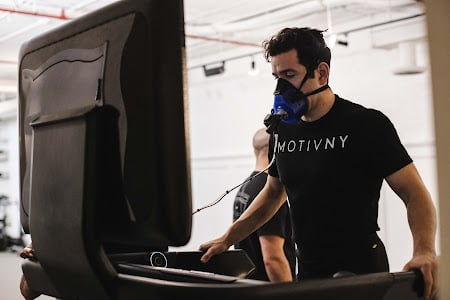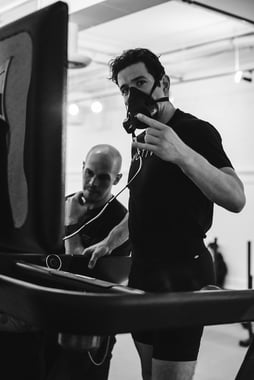V02 Max Testing in NYC: Why Anyone Can Benefit
March 8, 2023
The VO2 max test has been the gold standard for measuring fitness in aerobic sports such as running or cycling, but for decades has been largely inaccessible to the general public. In the last few years, companies like PNOĒ have created portable devices that allow everyday athletes to get tested and use the information for their own training regimens. This blog describes the testing process, the information it relays, and how that data can inform your training decisions.

Background of V02 Max
VO2 max testing is a method used to measure the maximum amount of oxygen that an individual can utilize during exercise. This test is often used by athletes and fitness enthusiasts to determine their aerobic capacity, which is a key indicator of overall fitness level.
During a VO2 max test, the individual is usually required to exercise on a treadmill or stationary bike while wearing a mask that measures the amount of oxygen and carbon dioxide that is inhaled and exhaled. The intensity of the exercise is gradually increased until the individual reaches their maximum exertion level.
There are several benefits to undergoing a VO2 max test. Firstly, it can provide valuable information about an individual's cardiovascular fitness and can help determine their optimal exercise intensity levels. It can also help identify any potential health issues, such as heart disease or lung function problems, which can impact an individual's exercise performance.
Additionally, VO2 max testing and re-testing can be used to monitor an athlete's progress over time. By measuring changes in that person's aerobic capacity, they or their coach can adjust their training programs accordingly in order to help them achieve their performance goals.
The Science of V02 Max
VO stands for volume of oxygen; therefore VO2 max stands for maximum oxygen uptake. The three terms of VT1, VT2, and VO2 max are most relevant to an understanding of how the human body processes and uses oxygen during exercise.
VT1 is called the first ventilatory threshold.
It is a marker of intensity at which lactate first begins to accumulate in a person's blood. VT1 can also be observed as the point at which a person's breathing rate starts increasing. A person who is at VT1 can no longer talk comfortably but can still string a few words together while exercising.
At VT2, lactate has quickly accumulated in a person's blood.
At VT2, the intensity of exercise has visibly increased, as the person's breathing is now rapid and they can no longer speak. The duration at which a person can exercise is now limited due to the increased intensity. VT2 can also be called the respiratory compensation threshold (RCT) and the onset of blood lactate accumulation (OBLA).
VO2 max is the maximal consumption of oxygen.
This represents the maximum capacity of that person's body to take in, transport, and use oxygen during exercise and reflects a person’s cardiorespiratory fitness. Maximum heart rate can also be measured at this point.
Simply put, a ventilatory curve is described as such:
- Rest
- VT1 (breathing begins to increase)
- VT2 (out of breath, high intensity)
- VO2 max (exercise needs to conclude due to exhaustion)
Why V02 Max Testing Matters
A sedentary person will reach VT1, VT2, and VO2 max at a much lower intensities of exercise than a more physically active person. An extremely deconditioned person may reach his or her VT1 while just walking. Conversely, a more conditioned person may not reach this threshold until they are running. This translates to a lower VO2 max for the deconditioned person.
Beyond having a numerical data point that you can see change over time, a VO2 max test can also give you a lot of other useful information about the way your body tolerates exercise. The report generated by a test through PNOE, the system we use at MOTIVNY, gives you:
1. Heart Rate
Your HR max is typically calculated by subtracting your age from 220 as a general estimate; this test will give you a number specific to you. It will also give you heart rate thresholds for your ventilatory thresholds (VT1, VT2) so that you can use heart rate to measure your intensity when exercising.
2. Training Zones
Traditionally, your heart rate zones are based on a percentage of your age-estimated HR max. For example, if I am 30 years old and want to exercise in my heart rate zone 2, I would calculate 60%-70% of 190 (220 minus 30), which would give me 114 - 133. These are, again, estimates based on averages. By doing a VO2 max test, I can observe whether my zone 2 is at a higher or wider range, and tailor my exercise based on that.
3. Energy Consumption
Your test will break down the percentage of carbohydrate vs. fat usage in each zone of training. This information is invaluable for allowing you to tailor your nutrition planning and recovery based on the intensity of your workouts day to day.
4. Recommendations for training cadence and timing
Finally, a VO2 max testing report can give you guidelines on how often you should be doing cardio vs. resistance training, as well as how much rest time you should be giving between workouts or sets/reps. It is important to note that these guidelines are based on your self-reported goals, and can vary based on what you are trying to achieve.
Whether you are planning to sign up for an endurance race, stuck on a plateau in your training, or if this information just sounds relevant and interesting to you, then you are probably a great candidate for a VO2 max test. Email us at connect@motivny.com for more information today!


Jessica Hartnett
Doctor of Physical Therapist and self-proclaimed adrenaline junkie.
jess@motivny.com